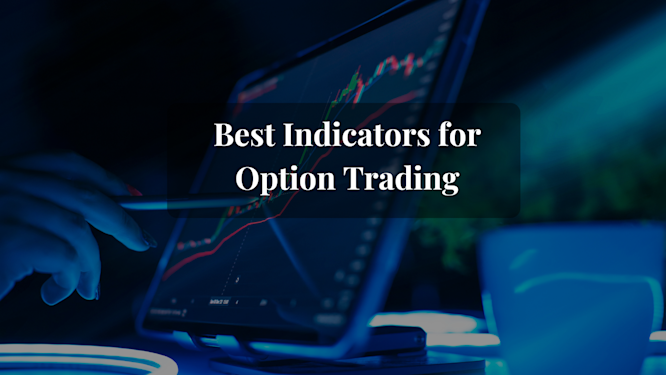Best Indicators for Option Trading
Options Trading
Trading options is an excellent way for investors and traders to capitalize on diverse market conditions. By employing various strategies, one can profit from both trending and sideways markets. However, options trading can sometimes be daunting due to its complexity. This is where technical indicators come into play. They allow traders to develop well-structured strategies that align with their unique trading style and enhance their decision-making process. In this blog, we’ll explore some of the best indicators for options trading and delve into how they can significantly improve your trading experience.
Best Indicators for Options Trading
1. Relative Strength Index (RSI)
The Relative Strength Index (RSI) is one of the most popular and widely used technical indicators among traders. It’s a momentum oscillator that evaluates the speed and magnitude of recent price changes, providing insights into whether a security is overbought or oversold. The RSI operates on a scale from 1 to 100.
Overbought Zone: When the RSI reading is above 70, the asset is considered overbought, indicating a potential reversal or price correction.
Oversold Zone: A reading below 30 signifies an oversold condition, suggesting that the price might rebound upward.
For options traders, RSI is a valuable tool to determine exit points for long positions and entry points for short trades. By analyzing momentum, traders can make informed decisions to capitalize on market inefficiencies.
2. Bollinger Bands
Volatility is a critical factor in options trading, and Bollinger Bands are among the best indicators to measure it. This tool consists of three lines:
A simple moving average (middle band).
An upper band (two standard deviations above the moving average).
A lower band (two standard deviations below the moving average).
When the price approaches the upper band, it often indicates that the security is overbought. Conversely, when the price nears the lower band, it signals oversold conditions.
Bollinger Bands expand during periods of high volatility and contract during low-volatility phases. Traders can use this behavior to predict potential breakouts or reversals, allowing them to enter or exit trades with precision.
3. Intraday Momentum Index (IMI)
The Intraday Momentum Index (IMI) is tailored for intraday traders and combines the principles of RSI with candlestick analysis. This indicator helps traders spot intraday trends and make decisions based on short-term price movements.
IMI is calculated by dividing the total number of up days by the sum of up and down days, then multiplying the result by 100. Similar to RSI:
An IMI above 70 indicates overbought conditions.
An IMI below 30 signals oversold conditions.
Intraday traders use IMI to identify ideal entry and exit points, enabling them to capitalize on short-term market fluctuations effectively.
4. Money Flow Index (MFI)
The Money Flow Index (MFI) is particularly useful for stock options traders. Known as the volume-weighted RSI, MFI evaluates the inflow and outflow of money in a security over a specific period.
MFI readings range from 1 to 100:
A reading above 80 suggests the asset is overbought.
A reading below 20 indicates the asset is oversold.
By incorporating volume data, the MFI provides a more comprehensive view of trading pressure, making it an essential tool for analyzing stock-specific options.
5. Put-Call Ratio (PCR) Indicator
The Put-Call Ratio (PCR) is a sentiment analysis tool that measures the ratio of put options to call options being traded. It offers insights into market sentiment:
Bullish Sentiment: A PCR above 1 indicates that more calls are being traded, suggesting optimism in the market.
Bearish Sentiment: A PCR below 1 signifies that puts are dominating, reflecting a bearish outlook.
Some traders also use PCR as a contrarian indicator, entering trades in the opposite direction of the prevailing sentiment to exploit market overreactions.
6. Open Interest (OI)
Open Interest (OI) is a critical indicator for options traders as it reflects the total number of open contracts at a given strike price. Although OI doesn’t indicate price direction, it provides valuable information about the strength of a trend:
Increasing OI: Suggests that the trend is gaining momentum and is likely to continue.
Decreasing OI: Indicates that the trend may be losing strength.
Traders often analyze OI alongside price movements to develop advanced strategies and assess market trends effectively.
Combining Indicators for Better Results
While each indicator has its strengths, relying solely on one may lead to inaccurate decisions. A better approach is to combine multiple indicators to gain comprehensive insights into market conditions. For instance:
Use RSI alongside Bollinger Bands to validate overbought or oversold conditions.
Combine OI with PCR to assess trend strength and market sentiment simultaneously.
Integrate MFI with IMI for a holistic view of momentum and trading pressure.
Conclusion
Options trading offers lucrative opportunities for traders to generate additional returns. However, it also comes with challenges that require a strategic approach. Technical indicators serve as powerful tools to refine trading strategies, improve decision-making, and enhance overall performance. By combining multiple indicators and incorporating price action analysis, traders can make more informed decisions and minimize risks.
While indicators provide valuable insights, it’s essential to remember that no tool is 100% accurate. Continuous learning, practice, and adapting to market conditions are key to long-term success in options trading.
FAQs
1. Which is the best option trading indicator?
The best indicator depends on your trading style and objectives. For momentum-based strategies, RSI and IMI are excellent choices. For volatility analysis, Bollinger Bands work best. If you’re analyzing market sentiment, the Put-Call Ratio is highly effective.
2. How to interpret the RSI?
RSI values range from 1 to 100:
Above 70: The asset is overbought, indicating a potential reversal or correction.
Below 30: The asset is oversold, suggesting a possible price rebound. Traders often use these levels to identify entry and exit points.
3. Which is the most accurate option trading indicator?
No indicator is universally accurate, but combining indicators like RSI, Bollinger Bands, and OI can improve accuracy. Each indicator’s effectiveness depends on the market conditions and the trader’s strategy.
4. What does a decline in price and a rise in open interest indicate?
A price decline coupled with increasing OI suggests that new positions are being added to the market, reinforcing the downward trend. This is often seen as a sign of strong bearish sentiment.
5. What is the most common period for MFI?
The default period for MFI is 14, similar to RSI. This period provides a balanced view of trading pressure over time, but traders can adjust it based on their preferred timeframe or strategy.



